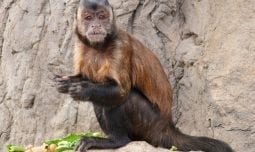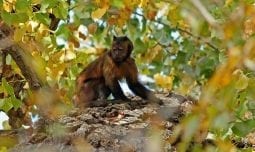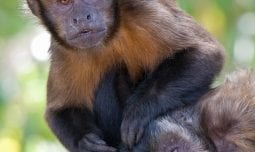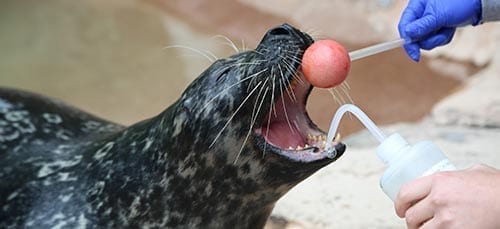Classification
Class Mammalia
Order Primates
Family Cebidae
Genus Sapajus
Species apella
Habitat & Range
Hooded capuchins live in sub-tropical humid and semi-deciduous forests. In Bolivia and Argentina they live in seasonal subtropical laurel and montane forests up to 5000 ft. In Paraguay, they live in dense humid semi-deciduous forest and gallery forests in areas of thorn scrub and savannah.
They live in South America, specifically Southeastern Bolivia, Northern Argentina, Brazil and Paraguay.

Hooded Capuchin
Sapajus apella
Capuchins are the most intelligent New World monkeys – perhaps as intelligent as chimpanzees. They are noted for their ability to fashion and use tools. For instance, they have been observed using rocks to crack open nuts.
Adaptations
- They are mainly arboreal but do forage on the ground.
- They are diurnal and feed all day with a short rest at midday.
- They have semi-prehensile tails that help them stabilize movement or act like a brake.
- They have opposable thumbs and big toes. They can also walk upright so that they can carry food; they fashion and use objects as tools and to manipulate food.
- They are considered to be very intelligent, some think as intelligent as chimpanzees.
Physical Description
- Hooded capuchins are 12-22 inches (30-56 cm) long with a 15-22 inch (38-56 cm) tail
- Adults weigh six to eight pounds (3-4 kg).
- Hooded Capuchin are not sexually dimorphic but males may have darker appearing fur..
- They have a brownish crown with two tuft-like horns of fur.
- They are overall quite pale, and differ from other tufted capuchin because the hair on the back of the neck and dorsal part of the tail is burnt brown, with a greyish brown dorsal body, shoulders, front upper arms, saddle, rump and thighs and black forearms and legs, black hands, wrists and feet.
Diet
What Does It Eat?
In the wild: They are omnivores eating mostly fruit, young leaves including succulent leaf bases, insects, small animal prey and flower nectar.
At the zoo: They are provided a large variety of vegetables, greens, seeds and bugs. Nuts are given as treats for training.
What Eats It?
Eagles, especially harpy eagles, and jaguars. Some human hunting occurs and capuchins are collected for the pet trade.
Social Organization
Typically live in groups of about 6-30 individuals, consisting of related females, offspring, subordinate males and a dominant male with primary mating rights; male offspring leave the group at about 6 years old. There is a distinct foraging social hierarchy: tolerated females and offspring form a leading edge; followed by the dominant male in the center; followed by the juveniles. Non-tolerated individuals are on the periphery. This provides tolerated individuals the best access to food, and reduces aggression for non-tolerated individuals, at the expense of less food and a greater risk of predation – although not so much as if they were alone. Grooming helps social cohesion. They are very vocal and territorial, using urine for marking and to show sexual maturity and individuality. Facial expressions include: relaxed open mouth, silent bared teeth, a mix of these two, lip smacking showing reassurance, open mouth threat, protruded lip and scalp lifting to accentuate other displays. Studies with captive tufted capuchins indicate groups are matrilineal and that there are complex dynamics within the group.
Life Cycle
Hooded capuchins live about 25 years in the wild and up to 40 years in zoos. Females become sexually mature at about 4 years; males at about 7-8 years. Breeding occurs year round and females showing only behavioral changes when in estrus, no morphological changes. They will follow a male, showing submissive postures, along with touching, grimacing and vocalization with a whine or whistle. The male may be indifferent at first and then he will copulate - up to once a day. After a 160 -180 day gestation period a single infant is born. The baby clings to the back of its mother until 6 months old and is weaned in one year. The female gives birth about every 2 years.
Collection Connection
- The hooded capuchins are found near the train and carousel and can travel to the outdoor Monkey Island using an underground passage. All the capuchin monkeys are female expect for Cuzco.
- Bailey - DOB: 3/15/82. Bailey is mother to Lynne, Joanie, Mitzie, Susan and Kerry
- Lynne - DOB: 5/15/00
- Susan – DOB 8/31/97
- Little Mitzie - DOB: 7/21/90
- Joanie - DOB: 7/5/92.
- Kerry - DOB: 3/9/87
- Ginger - DOB: 11/20/97
- Zelda - DOB: 11/10/96.
- Drew - DOB: 7/18/94.
- Cleopatra - DOB: 7/6/92.
- Katie - DOB: 11/1/95. Katie was brought to the zoo after being a part of the pet trade. She was not fed well and has a short stature from a lack of nutrition. She loves people and is our most expressive capuchin. She will “flirt” with new people and is often watching visitors outside. She lives with her daughter, Dede.
- Dede - DOB: 10/26/00.
- Cuzco (male) - DOB: 10/03/00.
Conservation Connection
IUCN Status: Least Concern
Hooded capuchins are common and widespread across their range. Their high reproductive rate and adaptability seems to compensate for inroads from hunting and habitat loss. Capuchin are very popular in the pet trade, but make poor pets as they need a lot of attention and specialized diets.

Download the App!
Get the FREE Denver Zoo app today, and be a pro the next time you visit the Zoo. You’ll get access to the Zoo map, daily activities and schedules, animal facts, and more. You can even load your membership card onto the app for additional convenience. It puts everything you need for an amazing Zoo experience right into the palm of your hand!






